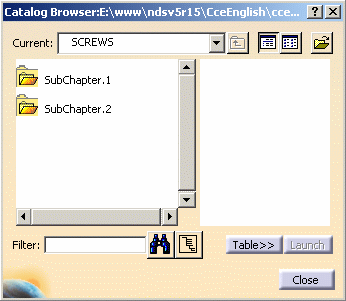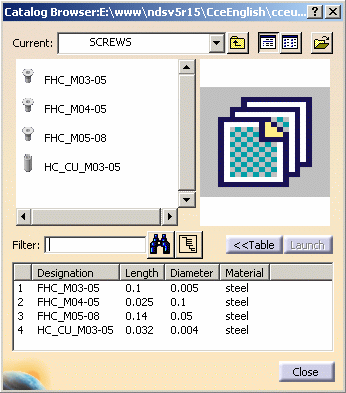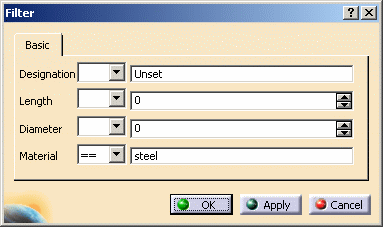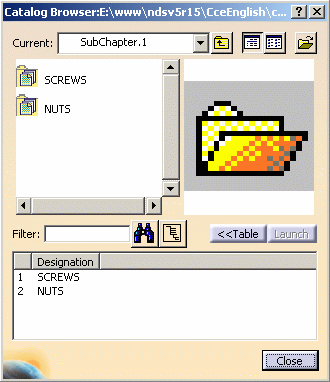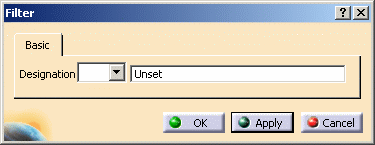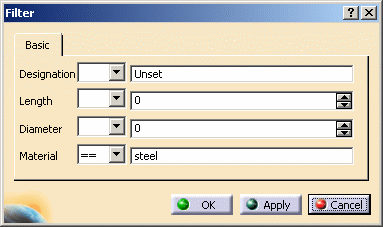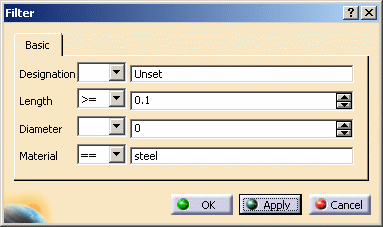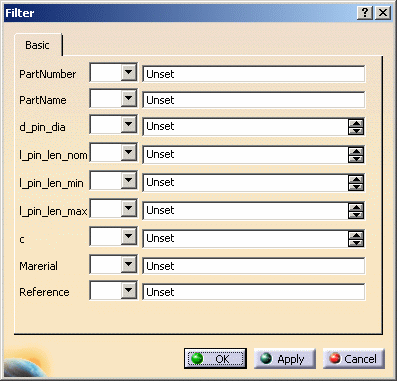 |
This task explains how to create an advanced filter on a
catalog from the Catalog Browser.
If a chapter contains a large number of entities one of
the most effective ways of finding the entities you need is to narrow the
selection criteria by means of the keywords you initially used to create
the catalog.
|
|
The Catalog Browser is available from the Catalog
Editor workbench and from several other workbenches, e.g. Assembly
Design, Part Design, Generative Shape Design and Drafting. You can
perform single-level queries and multiple-level queries. |
|
Filtering on one level
|
 |
-
Click
the icon
 ,
if available, or select the Tools -> Catalog Browser or the
Tools -> Open Catalog... command to open the Catalog
Browser. Note that the command name varies according to the workbench
you are working in. ,
if available, or select the Tools -> Catalog Browser or the
Tools -> Open Catalog... command to open the Catalog
Browser. Note that the command name varies according to the workbench
you are working in.
-
Click the Browse another catalog icon
 to navigate to the
catalog to be queried. In our example, we will use Catalog1.catalog
provided in the samples
folder. to navigate to the
catalog to be queried. In our example, we will use Catalog1.catalog
provided in the samples
folder.
-
Double-click SubChapter.1 then double-click
SCREWS. You can click the Table>> button to
display the keywords defined for the components along with the
corresponding values:
-
Click the Filter icon
 . .
The Filter dialog box appears and the keywords that have been defined
for the SCREWS family are displayed.
In the Filter dialog box, choose the operators from
the values proposed in the pull-down lists, then enter the
corresponding values/strings.
-
Under the Basic tab, select the following values:
This filter will search for any component with a Length lower
than 0.1 and with a Diameter greater than 0.01.
-
Click Apply then OK to launch the
filter.
The filter syntax is displayed in the Filter field of the
Catalog Browser and the search result is as follows:
-
Click the Close button to exit the Catalog
Browser.
|
| |
Filtering on multiple levels
|
 |
-
Click the icon
 ,
if available, or select the Tools -> Catalog Browser command
to open the Catalog Browser. ,
if available, or select the Tools -> Catalog Browser command
to open the Catalog Browser.
Note that:
- the command name may vary according to the workbench you are
working in,
- the browser must be accessed from a workbench (such as
Assembly Design) and not from the Catalog Editor.
-
Click the Browse another catalog icon
 to navigate to the
catalog to be queried. In our example, we will use Catalog1.catalog
provided in the samples folder: to navigate to the
catalog to be queried. In our example, we will use Catalog1.catalog
provided in the samples folder:
-
Double-click SubChapter.1 then click the Table>>
button:
-
Click the Filter icon
 . .
As you can see it above, the regular filter mode displays only
the keywords defined at the subchapter level.
-
Click Cancel to close the Filter dialog box.
-
Click the Enable multi-level filter icon
 then the
Filter icon then the
Filter icon
 . .
All the keywords that have been defined for the
families contained in SubChapter.1 are retrieved and you can then
perform your filter on any family contained in SubChapter.1 without
having to access each family specifically.
-
Under the Basic tab, select the following values:
In our example, we will search for any component with a Length
greater than 0.1.
-
Click Apply then OK to run the
search.
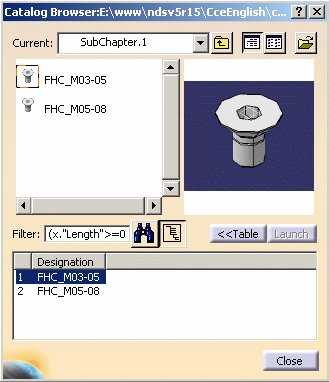
Note that if no filter is displayed in the Filter field, a
message appears to ask you if you want to retrieve all the
descriptions contained in the current chapter and its sub-chapters.
If you click Yes, all the descriptions will be
displayed. |
-
Click the Close button to exit the Catalog
Browser.
|
 |
If the number of results matching your filter is greater than 500,
two buttons are displayed to the right of the Enable multi-level
filter icon  : :
- the Show 500 previous
 button lets you
display the 500 previous descriptions. Note that this button is
activated as soon as you click the Show 500 next button button lets you
display the 500 previous descriptions. Note that this button is
activated as soon as you click the Show 500 next button
- the Show 500 next
 button lets you display
the 500 next descriptions. button lets you display
the 500 next descriptions.
|
|
Filtering from the Catalog Editor
|
 |
-
Open one of the default catalogs provided
with the Catalog Editor, ISO for instance. By default, it is located
in:
|
|
-
Double-click the catalog entity you wish
to filter (in our example, we use the ISO_8734_STEEL_PARALLEL_PIN in
the Pins family).
-
Click the Filter icon
 . .
The Filter dialog box appears.
-
Select the operators from the pulldown
lists for the selected parameters along with the corresponding values
or strings.
-
Select Apply then OK
to run the filter. The filter syntax is displayed in the Filter field
of the Catalog Editor and the result is as follows:
When you enter several criteria, the default operator
is "AND" (as shown in the above screen grab) but you can change it to
"OR" in the Filter field.
|
 |
The Clear Filter
 icon lets you clear the currently displayed filter but the filter
history is still accessible via the pulldown list.
icon lets you clear the currently displayed filter but the filter
history is still accessible via the pulldown list.
|
|
 |
